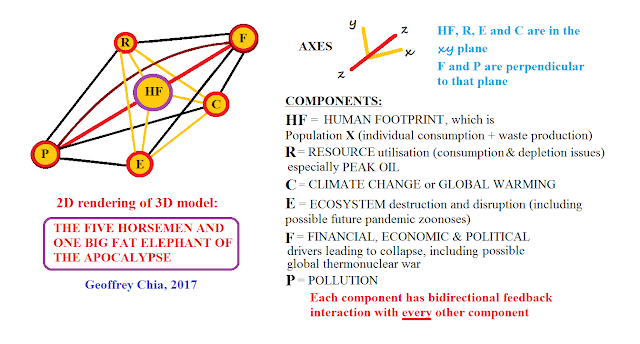The Limits to Growth was published in 1972 by a group of world class scientists using the best mathematical computer modelling available at the time. It projected the future collapse of global industrial civilisation in the 21st century if humanity did not curb its population, consumption and pollution. It was pilloried by many “infinite growth on a finite planet” economists over the decades.
However, updated data inputs and modern computer modelling in recent years (particularly by Dr Graham Turner of the CSIRO in 2008 and 2014) showed that we are in reality closely tracking the standard model of the LtG, with industrial collapse and mass die-off due sooner rather than later. The future is now.
It is a refinement of my older, less complete, 2D model “the three horsemen and one big fat elephant of the apocalypse“, originally conceived as a joke, a play on a hackneyed biblical phrase, albeit with serious intent.
In reality we are poised to fall off the cliff of net energy availability very soon 1,2and not even the most optimistic carbon sequestration fantasies (all of which will require colossal energy inputs and none of which are proven) will be able return us to a stable climate unless the total human footprint is also reduced drastically and immediately 3 (which will not happen short of global nuclear war – which in itself will exponentially release greenhouse gases, devastate remaining ecosystems and destroy industrial civilisation and thus our ability to technologically sequester GHGs).
Here is a 10 second video-clip, my first attempt to make this 3D model in real life, “doom explained by confectionery abuse”
Examples:
R affecting F: every major oil disruption eg 1973, 1979, has always resulted in economic recession. Another R affecting F example: diminishing per capita resources leads to economic hardships, shattered expectations and anger in the population, which leads to the rise of megalomaniacal fascist demagogues, multiplying the risk of global conflict.
R causing C: this is obvious
C affecting R affecting C: as heatwaves worsen, airconditioning use and hence fossil fuel consumption escalate, liberating more GHGs and worsening global warming













































